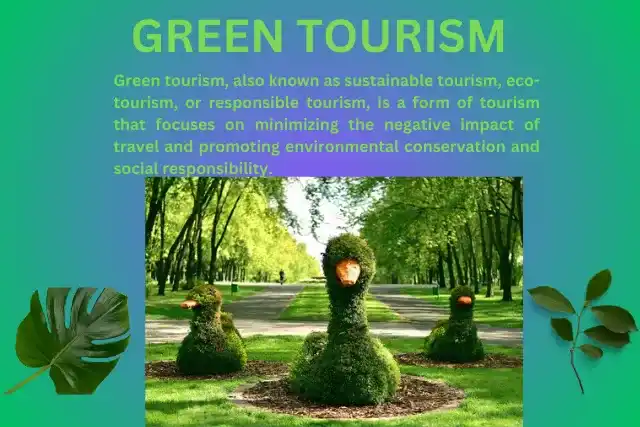
Green Tourism and its Example
Green tourism, also known as sustainable tourism, eco-tourism, or responsible tourism, is a type of travel that focuses on minimizing the negative impact of tourism and promoting environmental conservation, cultural preservation, and social responsibility. This article provides an overview of the importance of green tourism and the various types of sustainable tourism practices. Additionally, it highlights Costa Rica as an example of a country that has successfully implemented sustainable tourism practices.
Green tourism provides a unique and enriching travel experience that encourages personal growth and learning while contributing to the preservation of the natural and cultural heritage of the destination.
What is Green Tourism?
Green tourism, also known as sustainable tourism, eco-tourism, or responsible tourism, is a form of tourism that focuses on minimizing the negative impact of travel and promoting environmental conservation and social responsibility.
Green tourism aims to create a balance between economic growth and environmental and social responsibility, allowing tourists to enjoy travel experiences while also contributing to the preservation of the natural and cultural heritage of the destination.
Why is green tourism important?
Green tourism is important because it supports environmental conservation, economic development, cultural preservation, climate change mitigation, and personal growth.
Green tourism, also known as ecotourism or sustainable tourism, is important for several reasons.
- Environmental conservation
- Economic development
- Cultural preservation
- Climate change mitigation
- Personal growth
- Reducing environmental pollution
- Wildlife protection
- Community involvement
- Education and awareness
- Long-term sustainability
Environmental conservation
Green tourism promotes the conservation of natural resources, wildlife, and ecosystems. It encourages tourists to appreciate and respect nature and to minimize their impact on the environment.
Economic development
Sustainable tourism can provide economic benefits to local communities by creating jobs and generating income. This can help to alleviate poverty and improve the standard of living for local residents.
Cultural preservation
Green tourism often involves visiting remote and rural areas where local cultures and traditions are still intact. This can help to preserve and promote cultural diversity.
Climate change mitigation
Sustainable tourism can help to reduce greenhouse gas emissions by promoting low-carbon transportation, energy-efficient accommodations, and sustainable food practices.
Personal growth
Green tourism can provide a unique and enriching travel experience that encourages personal growth and learning. It can help tourists to develop a deeper appreciation and understanding of the natural world and different cultures.
Reducing environmental pollution
Green tourism promotes responsible travel practices, such as reducing waste, conserving water and energy, and using eco-friendly products. This can help to reduce pollution and minimize the negative impacts of tourism on the environment.
Wildlife protection
Ecotourism often involves visiting natural areas where wildlife habitats are preserved. This can help to protect endangered species and support conservation efforts.
Community involvement
Sustainable tourism encourages community involvement in tourism development and decision-making. This can help to ensure that tourism benefits are shared fairly among local residents and that their voices are heard in tourism planning and management.
Education and awareness
Green tourism can raise awareness about environmental and social issues and promote sustainable living practices. This can help to inspire tourists to make positive changes in their own lives and contribute to global efforts to address these challenges.
Long-term sustainability
Sustainable tourism aims to balance economic, environmental, and social considerations in tourism development and management. This can help to ensure that tourism is sustainable in the long term and that future generations can also benefit from the natural and cultural resources that tourism provides.
Types of Green Tourism
There are several types of green tourism, each with its own focus and approach to sustainable tourism. Here are some of the most common types
The types of green tourism include cultural tourism, wildlife tourism, geotourism, health and wellness tourism, and volunteer tourism. Each type has a different focus and approach to promoting sustainable tourism.
Ecotourism
This type of green tourism involves visiting natural areas and engaging in activities that promote conservation and environmental awareness. Ecotourism aims to minimize the impact of tourism on the environment and support local conservation efforts.
Agritourism
Agritourism involves visiting farms and rural areas to learn about local agriculture, food production, and rural lifestyles. This type of tourism supports sustainable agriculture and promotes awareness about food systems and environmental sustainability.
Community-based tourism
Community-based tourism involves working with local communities to develop and manage tourism activities that benefit both tourists and local residents. This type of tourism promotes cultural exchange, community development, and sustainable livelihoods.
Adventure tourism
Adventure tourism involves engaging in outdoor activities, such as hiking, rafting, and climbing, that promote environmental awareness and appreciation of natural areas. This type of tourism often involves using eco-friendly equipment and practices to minimize environmental impact.
Sustainable tourism
Sustainable tourism aims to balance economic, environmental, and social considerations in tourism development and management. This type of tourism promotes responsible travel practices and supports local communities and conservation efforts.
Cultural tourism
Cultural tourism involves visiting destinations to learn about the history, traditions, and cultural practices of a particular region or community. This type of tourism supports the preservation and promotion of local cultural heritage.
Wildlife tourism
Wildlife tourism involves visiting natural areas to observe and learn about wildlife in their natural habitat. This type of tourism promotes conservation efforts and responsible wildlife viewing practices.
Geotourism
Geotourism involves visiting destinations to learn about the geological features and processes of a particular region or area. This type of tourism promotes awareness about earth sciences and environmental sustainability.
Health and wellness tourism
Health and wellness tourism involves visiting destinations to engage in activities that promote physical and mental health, such as yoga, meditation, and spa treatments. This type of tourism often incorporates eco-friendly and sustainable practices.
Volunteer tourism
Volunteer tourism involves participating in community development or conservation projects as part of a tourism experience. This kind of tourism encourages civic engagement and aids in the local community’s sustainable development.
Which country is an example of green tourism?
There are many countries that are implementing sustainable tourism practices and promoting green tourism. One country that is often cited as an example of green tourism is Costa Rica.
Costa Rica has made significant efforts to promote ecotourism and sustainable tourism practices. The country has a diverse range of natural and cultural attractions, including rainforests, beaches, volcanoes, and wildlife reserves. The government and tourism industry in Costa Rica have worked together to develop a sustainable tourism strategy that includes protecting natural areas, supporting local communities, and promoting responsible travel practices.
Conclusion
Green tourism, also known as sustainable tourism, is a type of travel that focuses on minimizing the negative impact of tourism and promoting environmental conservation, cultural preservation, and social responsibility. It is essential for environmental conservation, economic development, cultural preservation, climate change mitigation, personal growth, and long-term sustainability. There are several types of green tourism, including ecotourism, Agritourism, community-based tourism, adventure tourism, sustainable tourism, cultural tourism, wildlife tourism, Geotourism, health and wellness tourism, and volunteer tourism.
You may like:




